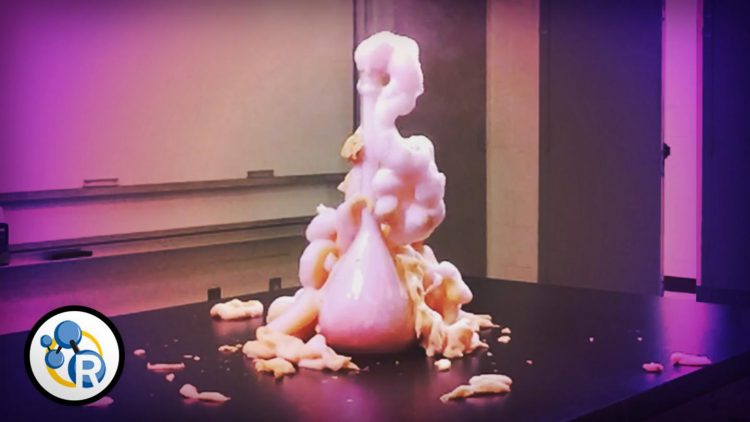Foam explosion in super slow motion (video)

You might have seen this wacky experiment in a chemistry class or on late-night TV. Dropping a mixture into some hydrogen peroxide produces a huge foamy flume. But what's actually causing that big mess? Turns out it's a great illustration of a key concept in chemistry. In this week's video, Reactions teams up with chemistry professor Matt Hartings, Ph.D., to explain the Elephant Toothpaste experiment. Check it out here: https://youtu.be/PX7TIqAJRSY. Credit: The American Chemical Society
Dropping a mixture into some hydrogen peroxide produces a huge foamy flume. But what's actually causing that big mess?
Turns out it's a great illustration of a key concept in chemistry.
In this week's video, Reactions teams up with chemistry professor Matt Hartings, Ph.D., to explain the Elephant Toothpaste experiment.
Check it out here: https:/
###
Subscribe to the series at http://bit.
The American Chemical Society is a nonprofit organization chartered by the U.S. Congress. With more than 158,000 members, ACS is the world's largest scientific society and a global leader in providing access to chemistry-related research through its multiple databases, peer-reviewed journals and scientific conferences. Its main offices are in Washington, D.C., and Columbus, Ohio.
To automatically receive news releases from the American Chemical Society, contact newsroom@acs.org.
Media Contact
All latest news from the category: Life Sciences and Chemistry
Articles and reports from the Life Sciences and chemistry area deal with applied and basic research into modern biology, chemistry and human medicine.
Valuable information can be found on a range of life sciences fields including bacteriology, biochemistry, bionics, bioinformatics, biophysics, biotechnology, genetics, geobotany, human biology, marine biology, microbiology, molecular biology, cellular biology, zoology, bioinorganic chemistry, microchemistry and environmental chemistry.
Newest articles

Sea slugs inspire highly stretchable biomedical sensor
USC Viterbi School of Engineering researcher Hangbo Zhao presents findings on highly stretchable and customizable microneedles for application in fields including neuroscience, tissue engineering, and wearable bioelectronics. The revolution in…

Twisting and binding matter waves with photons in a cavity
Precisely measuring the energy states of individual atoms has been a historical challenge for physicists due to atomic recoil. When an atom interacts with a photon, the atom “recoils” in…

Nanotubes, nanoparticles, and antibodies detect tiny amounts of fentanyl
New sensor is six orders of magnitude more sensitive than the next best thing. A research team at Pitt led by Alexander Star, a chemistry professor in the Kenneth P. Dietrich…





















